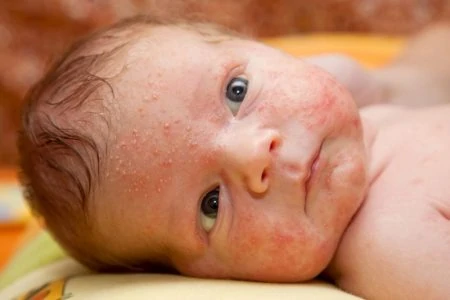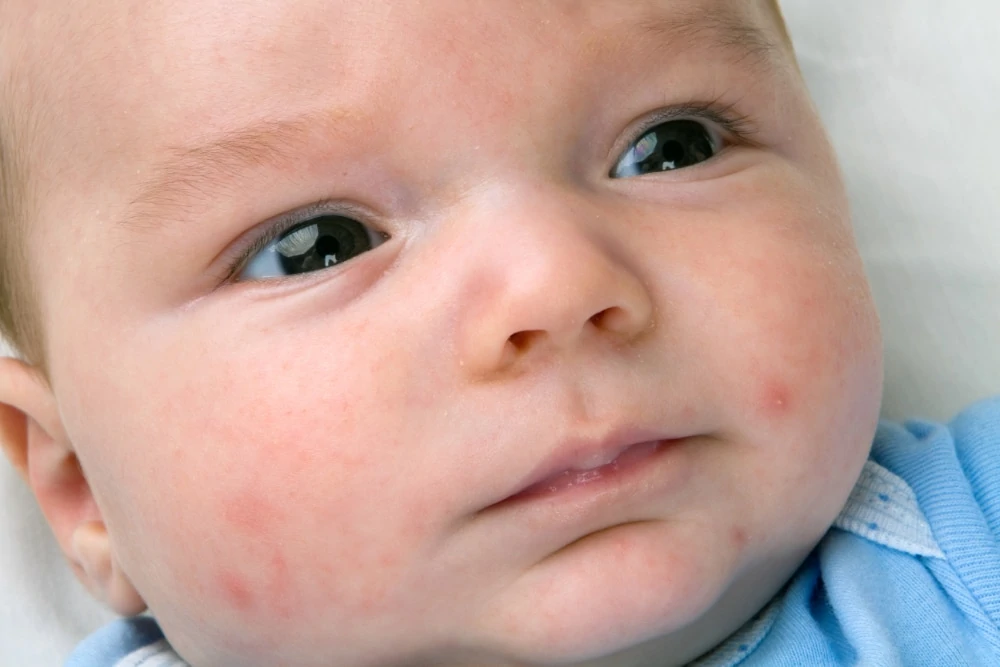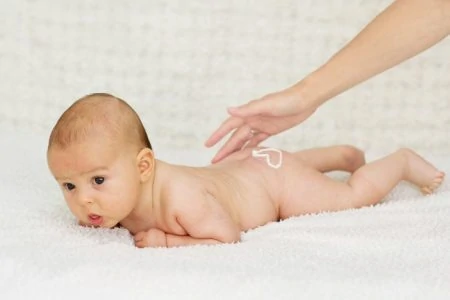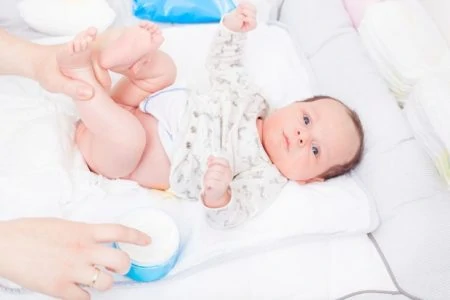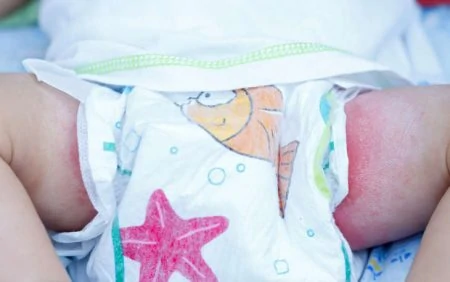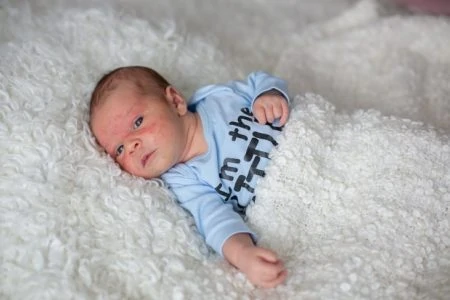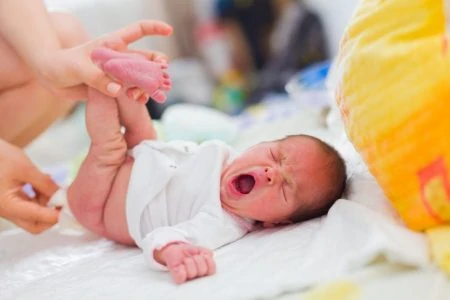Is your baby developing red, pimple-like bumps on their sweet little face?
Acne is not exclusively for teenagers; babies get it too. Seeing spots on your newborn does not mean they skipped infancy and went straight to puberty. Fortunately, there is rarely a need for medical intervention. Baby acne is entirely normal, and many parents experience this during the first few months.
In this article, we will cover the causes of baby acne, how to identify it, and the best ways to care for your baby’s skin.
Key Takeaways
- Identify the type: Neonatal acne appears before 6 weeks and is very common. Infantile acne appears between 3 and 16 months and is rarer.
- Understand the cause: Breakouts are often triggered by maternal hormones stimulating the baby’s oil glands, though yeast can also play a role.
- Timeline: Neonatal acne usually clears within a few weeks to months. Infantile acne may persist longer and require a doctor’s attention.
- Treatment: Keep the face clean with water, pat dry gently, and avoid scrubbing or using oily lotions.
What Is Baby Acne?

Baby acne describes acne-like breakouts on a newborn or infant. It is usually a temporary skin condition that causes red or whitish bumps on the face and body.
Doctors divide these breakouts into two distinct categories: neonatal acne and infantile acne.
1. Neonatal Acne
Neonatal acne occurs before a baby reaches 6 weeks of age. Approximately 20% of newborns develop this type, and it affects boys more often than girls. Some babies are even born with it.
Most medical professionals do not consider this “true acne” in the same sense as teenage pimples.
Neonatal acne generally appears on the face, specifically the forehead, cheeks, and chin. Occasionally, it spreads to the upper back or chest. The affected skin may look bumpy and red, or it may present as small, scattered red dots.
2. Infantile Acne
Infantile acne occurs when a baby is between 3 and 16 months old. This type is much less common and affects approximately 2% of babies. Like neonatal acne, it is more prevalent in boys.
This variation looks closer to the acne teenagers experience. You might see red bumps, but you may also spot blackheads (comedones) and nodules. These typically surface in clusters, and the bumps may contain pus.
While infantile acne usually resolves on its own, it can be persistent. In rare cases, it lasts up to two years and may cause scarring if left untreated. Doctors generally view this type as true acne.
Why Does My Baby Have Acne?
The exact cause of baby acne remains partially mysterious, but medical experts have identified a few primary culprits. The leading theory involves hormones passed from mother to baby.
1. Maternal Hormones
Toward the end of pregnancy, maternal hormones pass through the placenta to the baby. These hormones stimulate the baby’s oil glands (sebaceous glands). This extra oil production can clog pores and lead to breakouts. This is the most common reason for neonatal acne.
2. Yeast
A specific type of yeast called the Malassezia species lives on the skin’s surface. While usually harmless, this yeast can cause an inflammatory response in some babies. This reaction may trigger an acne flare-up.
Some researchers suggest an overreaction to yeast is the primary cause of neonatal acne (1).
3. Skincare Products
Parents often use lotions and oils to combat dry skin. However, oily products can block tiny pores and trigger acne. A baby’s skin is extremely sensitive, so pore-clogging ingredients can easily cause an outbreak.
How Long Will My Baby’s Acne Last?
The duration depends on the type of acne your baby has.
Neonatal acne generally runs its course within a few weeks or months. It almost always clears up before the baby turns 4 months old. This type rarely leaves scars or marks.
Infantile acne can be more stubborn. It may last for six to twelve months, and sometimes longer. Because this type has a higher risk of scarring, it often requires a doctor’s supervision (2).
Is It an Indicator of Future Skin Problems?
Parents often worry that a bumpy baby face predicts a pimply teenage future.
If your child has neonatal acne, you can relax. There is no connection between newborn breakouts and teenage acne. It does not mean your child will have difficult skin later in life.
Infantile acne, however, has a stronger genetic link. Some studies suggest that babies with severe infantile acne may be more prone to breakouts during adolescence (3).
Similar Conditions
Several other skin conditions look like acne. Fortunately, most are harmless and resolve without treatment.
Here are the most common lookalikes.
1. Eczema (Atopic Dermatitis)
Eczema causes dry, itchy, red patches. It appears as rashes on the face, elbows, and knees (4).
How to tell the difference: Acne makes the skin look oily or shiny. Eczema makes the skin look dry, cracked, and scaly.
2. Erythema Toxicum
Erythema toxicum is a very common, harmless rash that affects about half of all newborns. It looks like blotchy red spots with small white or yellow centers (5).
How to tell the difference: This rash can appear anywhere on the body and usually fades within a week or two of birth.
3. Milia
Milia are tiny, pearly-white bumps that usually appear on the nose, chin, or cheeks. These bumps are simply trapped dead skin cells.
How to tell the difference: Milia are hard white bumps without the redness or inflammation associated with acne. They typically disappear within a few weeks (6).
4. Heat Rash
Heat rash occurs when sweat glands become blocked. It creates small red or pink bumps.
How to tell the difference: Heat rash usually appears in creases like the neck, armpits, or groin. It fades quickly once the baby cools down.
5. Cradle Cap
Cradle cap (seborrheic dermatitis) causes crusty, oily, or scaly patches on a baby’s scalp. It can sometimes spread to the forehead or eyebrows (7).
How to tell the difference: Cradle cap presents as yellow, greasy flakes rather than individual pimples.
Treatment for Baby Acne
You must treat baby acne differently than adult acne. Infant skin is fragile, and harsh chemicals can cause damage.
Important: Never pop, squeeze, or pick at your baby’s acne. This causes pain, increases the risk of infection, and can lead to permanent scarring.
Here are gentle ways to manage the condition.
1. Keep the Face Clean
Saliva, spit-up, and milk residue can irritate skin and worsen acne. Gently wipe your baby’s face after every feeding.
Wash their face daily with lukewarm water. If necessary, use a mild, soap-free cleanser designed for sensitive baby skin. Avoid scrubbing, as friction irritates the breakout.
2. Be Gentle With Towels
After washing, pat the skin dry with a soft towel. Do not rub.
Rubbing acts as exfoliation, which is too harsh for acne-prone baby skin. Simply dab the moisture away to avoid aggravating the bumps.
3. Skip the Heavy Lotion
While moisturizing is usually good, you should avoid applying heavy creams directly onto acne. Thick lotions can clog pores further. If the skin is not dry or peeling, it is often best to leave the acne spots alone to breathe.
4. Use a Humidifier
Dry air can irritate skin conditions. Using a humidifier in the nursery keeps the air moist, which helps the skin maintain its natural barrier.
5. Breast Milk
Breast milk contains lauric acid, which has antibacterial and anti-inflammatory properties (8).
Many mothers apply a few drops of breast milk to the affected area and let it air dry. While this is anecdotal, it is a safe and natural remedy to try.
6. Coconut Oil (Use With Caution)
Coconut oil contains vitamin E and lauric acid, which can soothe skin (9). However, coconut oil is also highly comedogenic, meaning it can clog pores.
If you choose to use it, apply a tiny amount to a test patch first. If the acne worsens, discontinue use immediately.
7. Avoid Harsh Detergents
Residue from strong laundry detergents can linger on sheets and clothes, irritating sensitive skin.
Switch to a dye-free and fragrance-free detergent for all baby laundry. This reduces the chemical load on your baby’s skin.
When to Seek Medical Advice
Neonatal acne (before 6 weeks) rarely requires a doctor’s visit. It is cosmetic and usually fades on its own.
However, you should consult your pediatrician if:
- The acne appears after 6 weeks of age: This could be infantile acne, which may need treatment to prevent scarring.
- There are blackheads or pus-filled cysts: These indicate a more severe case.
- The skin looks infected: Watch for extreme redness, swelling, or crusting.
Doctors may prescribe mild topical creams or oral medications for severe cases (10).
